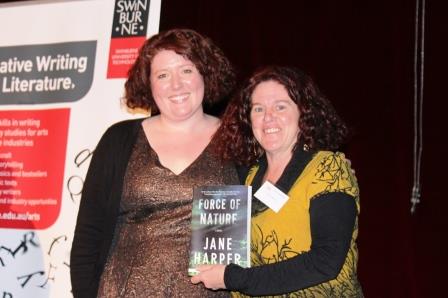Sisters in Crime member, Jess Byrne, is currently doing her PhD in Creative Writing at the University of Adelaide. It includes a 20,000 word exegesis which she has chosen to write on Sisters in Crime’s Davitt Awards. (Jess is is pictured here with 2017 Davitt Award winner, Jane Harper.)
Here is the paper she presented at the Australasian Association of Writing Programs, Perth on 28 November 2018. (Unfortunately, not all of Jess’s wonderful tables and charts would transfer to the website.)
It was a dark and stormy night in 1991 when Sisters in Crime Australia was established (Shute “Modus 2002”, 2; Shute “Modus 2001”, 1).
The establishment of the Sisters’ Davitts Awards ten years later were, by contrast, the product of a bright idea (Cameron 1):
In the lead-up to the [Sisters’ 2001] SheKilda convention, Sisters in Crime Australia had the bright idea (we had lots!) of a new crime writing award – The Davitt – to be awarded for the best crime novel by an Australian woman published in book form in Australia in the previous year … we thought that proper recognition of published Australian women crime writers was long overdue.
Now, in 2018, the Davitts celebrate their eighteenth year and have come of age, with 101 nominations for the award compared with seven in the inaugural award year of 2001. It is therefore timely to examine their establishment, development and impact.
The awards are named after Ellen Davitt who, in 1865, published Australia’s first mystery novel in serial form in The Australian Journal and who, according to Stephen Knight, ‘has a real claim to being the first female crime novelist’ for her book Force and Fraud (Sisters in Crime Australia “New Award”; Knight 3).
Nominations for the Davitt Awards are open to crime books published in the previous calendar year by Australian women (Sisters in Crime Australia “Entries 2018”). There is no money associated with the award. Entry is free and winners are provided with a hand-carved wooden trophies that display the winning books’ covers under perspex (Sisters in Crime Australia “The Davitt Awards”; Sisters in Crime Australia “Entries 2018”). Sponsorship is sought for the awards.
Aims of the Davitts
Seeing more Australian women crime writers published is a key aim in establishing the awards. The organisation maintains that publishers have been less likely to support local talent and more likely to bring in books by well-known international authors, such as Patricia Cornwell (Shute “Interview 2017”).
The awards also aim to build the confidence and skill of writers, improve the quality of women’s crime writing, and recognise and encourage innovation in the crime genre, a genre that is arguably highly masculinist (REF on innovation;) (Byrne 1).
But perhaps the most significant driver for establishing the awards was what the Sisters saw as the lack of recognition received by female writers within the Ned Kelly crime-writing awards and by reviewers, especially in the mainstream press.
The Neds
The Sisters have a point regarding the failure to recognise women in the Ned Kelly Awards. The only woman to appear in the list of Neds award winners in the first five years was Marele Day in 1997 for her non-fiction book How to Write Crime (Cameron 2). Things have improved – marginally.
Of the 79 awards across all Neds categories from 1995 to 2018, just under one third have gone to women: 25 to women compared to 54 for men (ACWA ).
| Ned Kelly Award Winners, All Categories, By Gender, 1995-2018 | ||
| Number | Per cent | |
| Male | 54 | 68 |
| Female | 25 | 32 |
| TOTAL | 79 | 100 |
Reviews
No evidential study has been undertaken on reviews of crime books written by women – an opportunity for further research.
However, the Stella Count has found that, across all genres, women’s representation in reviews in major national periodicals is consistently below that of men – for example, only 38 per cent in The Weekend Australian in 2017. Today’s audience will be pleased to know that in 2017 The Western Australian saw women’s representation in all reviews rise eight per cent from the previous year to 57 per cent (Harvey and Lamond n.p.).
Perhaps the salient point here is that convictions about the gender imbalance experienced by women crime writers was a springboard for Sisters in Crime to establish the Davitts and to continue in its work to encourage and promote women crime writers.
TRANSFORMATION OF THE AWARDS
The Ned Kelly and review figures might suggest that women have been absent from the crime genre. They were and are not. The history of the Davitt Awards demonstrates the presence of and growth in the number of women crime writers over the last two decades.
In their 18-year history, the awards have attracted 893 nominations for crime books published by women. In 2018, a record 101 books were nominated from 94 writers. This is a phenomenal growth rate from the seven books nominated in the award’s first year, 2001.
The overall growth across the award’s 18 years reflects six factors:
- the introduction of new award categories
- a broadening of eligibility to include e-books and self-published books
- a steady increase in the longlists for adult fiction books
- nominations of multiple serialised children’s books
- proactive work by Sisters in Crime to identify books and encourage their nomination
- and, importantly, a growth in the number of books published over the period.
I will briefly explore two of these.
Firstly, the introduction of new award categories
Since 2001, the Davitts have seen an expansion of award categories – including new sub-genres: non-fiction, children’s fiction and young adult fiction.
From one award category in 2001 the Davitts have grown to offer six book awards by 2014 (Sisters in Crime Australia “New Award”).
The six current book award categories are (Sisters in Crime Australia “The Davitt Awards”):
- Best Adult Crime Novel – 2001
- Best Young Adult Crime Novel – 2002
- Readers’ Choice (any category and voted by Sisters in Crime members) – 2002
- Best Non-fiction Book (named Best True Crime until 2015) – 2006
- Best Children’s Crime Novel – 2010
- Best Debut Book (any category) – 2012
The introduction of each new sub-genre has seen a spike in the total number of nominated books in that year or the following year. The introduction of children’s and debut book awards, at the same time, recognised the growing number of the books being published in each of these categories.
No separate nominations are made for the Readers’ Choice and Best Debut Book awards. These are drawn from books nominated in the genre categories.
Secondly, a brief look at the broadening of eligibility for the awards.
In the main, this has been the result of technological development and changes in the publishing industry.
E-books were not originally accepted into the award as these were considered inaccessible to the general public (Sisters in Crime Australia “Searching”). By 2014, the judges noted a large number of e-books. In that same year, the first e-book was shortlisted, Ilsa Evans’ adult novel Nefarious Doings: A Nell Forrest Mystery (King-Carmichael cited in Sisters in Crime Australia “Shortlist for 14th Davitts” 2).
Self-published books were accepted by Sisters in Crime until 2012. Following some lobbying, Sisters in Crime decided to accept them again in 2018 (Shute and Cameron).
IMPACT OF THE DAVITTS
So … after this whirlwind history of the Davitts, we come to the question of this paper: Have the Davitts – now that they have come of age – made space for Australian women crime writers?
 The first director of the Stella Prize, Aviva Tuffield, (left) reflecting on the greater number of winning women in the Miles Franklin in recent years, said, ‘“We do like to take some credit although we can’t prove any causality”’.
The first director of the Stella Prize, Aviva Tuffield, (left) reflecting on the greater number of winning women in the Miles Franklin in recent years, said, ‘“We do like to take some credit although we can’t prove any causality”’.
Sisters in Crime might well like to argue the same in relation to the Ned Kelly Awards.
And they may well be right. Three of the last seven Neds best novel winners are women, with 2012 Davitts winner Sulari Gentill winning the Neds’ Best Novel award this year.
Sisters in Crime has also argued that the Davitts have encouraged Australian publishers to consider crime written by local women. Again, they may be right.
In both cases the Davitts may – may – be able to take some credit. But causality? To prove causality or even influence would involve extensive research engaging with publishers, Ned Kelly judges, and the Australian Crime Writers Association, for a start. It would also require a consideration of the complex interactions between culture, cultural production and the influence and impact of literary awards (including on sales of books) – a vast subject of inquiry and beyond the scope of my Creative Writing exegesis.
What, then, can be said about the Davitts, their impact and their value? Certainly, it’s not money. While the Stella Prize offers $50,000 to the winner – and therefore the freedom to live and work as a writer for a period – the Davitts offer a wooden and perspex trophy. Given that the average Australian writer earns only $12,000 per year,[1] the trophy is nice for the shelf but not for the dinner table.
What the Davitts do offer is other value: recognition, validation and publicity. I will not mention here their impact on quality and genre innovation.
Recognition comes through the award itself, either as a winner or as a shortlisted author. The annual awards dinner is a rare moment in the sun for writers tapping away in the solitary dimness of study or backyard shed.
The award has value to authors because it is from a group of crime aficionados – readers, writers, publishers and general enthusiasts of crime fiction – a group of people Kerry Greenwood has described as ‘the world’s most educated audience when it comes to female mysteries’.[2]

Malla Nunn (left), Best Adult Novel winner in 2009, described those involved with the Davitts as her ‘peers’, which for her made the award particularly meaningful.
With recognition comes validation, of critical value to emerging writers and children’s authors in particular. Winner of the 2014 Best Children’s Novel, Jen Storer, praised the Davitts for the children-specific award because ‘[w]riting for children is commonly regarded as a lesser art and routinely marginalised’ and the award ‘helps to raise the profile of children’s literature and to validate the contribution, commitment and talent of Australian children’s authors’. It is worth noting that women make up 87 per cent of children’s authors in Australia.
Publicity. With the exception of major names such as Jane Harper and Liane Moriarty – both Davitt adult fiction winners – promotional budgets for most Australian women crime writers is small – either as an allocation from major publishers or because many are with small publishing houses.
The Davitts provide publicity through media releases to mainstream and specialised periodicals and sites detailing longlisted, shortlisted and winning books, which is frequently taken up – see The Age and Books+Publishing for example. Regional papers pick up stories about local authors. Where the authors are journalists – which is often the case for non-fiction crime – authors may receive publicity from the organisation where they undertake their day job.
Publishers and authors themselves can promote a book or author as ‘award-winning’ across a range of marketing platforms, including in reprints of winning books (although, given the small Australian market, this opportunity is somewhat curtailed). An award can have international marketing value. 2006 Young Adult Novel winner Catherine Jinks said:[3]
‘Evil Genius can now be described as an “award-winning novel”. That always looks good on a press release. And I’m grateful to Sisters in Crime for the perfect timing of this announcement, because Americans seem to love awards.’
 As an interesting aside, for Heather Rose (left), 2006 Adult Novel Davitt winner, the true value of the award came when she won the Stella in 2017 and could then promote herself as a ‘multi-awarding-winning’ novelist.[4]
As an interesting aside, for Heather Rose (left), 2006 Adult Novel Davitt winner, the true value of the award came when she won the Stella in 2017 and could then promote herself as a ‘multi-awarding-winning’ novelist.[4]
Community of support
The significance of these three things – recognition, validation and publicity – cannot be underestimated.
But the real value of the Davitts, I have discovered, is their place in the broader program of support, skills development and activities provided by Sisters in Crime Australia, such as events with guest speakers (think police officers and forensic pathologists), author networking, the SheKilda conferences, and the all-important Scarlet Stiletto short story award.
In fact, it is the Scarlet Stiletto short story competition – established in 1994 – that has proven to be the career and publication springboard for many Australian women crime writers. By 2018, a total of 3,471 stories had been entered into Stiletto competitions. Importantly, 24 of the winners have subsequently had novels published.
Davitt winners consistently recognise both the broader work of the Sisters and the value of the Stilettos. Here is a sample:
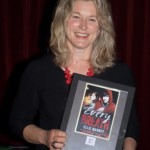 Ellie Marney (left), earlier Stiletto winner, on receiving the 2015 Davitt for the Best Young Adult Novel: “‘I got my first break through Sisters in Crime, and without [them], I probably wouldn’t even be here”’.
Ellie Marney (left), earlier Stiletto winner, on receiving the 2015 Davitt for the Best Young Adult Novel: “‘I got my first break through Sisters in Crime, and without [them], I probably wouldn’t even be here”’.
Fleur Ferris, 2016 Young Adult winner: ‘Sisters in Crime … supports and recognises the value of the work of every woman crime writer in this room.’
Kerry Greenwood (below), on winning the Lifetime Achievement Award in 2013:
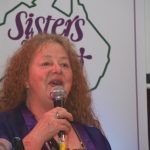
“‘Without the support of Sisters in Crime, who truly are sisters in the sense that Sisterhood is Powerful, many female crime writers would not have been encouraged to continue and we would have missed out on many fine books. Not to mention those who have got their start by venting their fury in the Scarlet Stilettos crime writing awards.”
Final word
To conclude, the Davitt Awards have grown, developed, and offered value to authors. Their true impact, however, is hard to gauge. They do not stand alone but are an important component of the broader commitment and work of Sisters in Crime Australia.
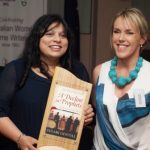
For Sulari Gentill (left with Asa Larsson, right): “‘To receive any literary award is gratifying, but when the award is the Davitt – for which writers would not only kill, but in fact must kill in order to be eligible – it is a truly extraordinary honour’’.
But the final word goes to RA Spratt (below) in accepting the Davitt – that hand-crafted wooden and perspex trophy – for the Best Children’s Crime Novel of 2016: “‘… the main reason I’m so happy to finally have won an award, an actual physical award that I can hold in my hand, is that it is such a 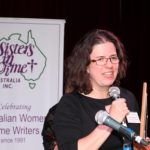
lovely blunt instrument. And no-one can appreciate more than the [Sisters in Crime], the potential of a really interesting blunt instrument.’”
Thank you.
REFERENCES
Australian Crime Writers Association. “Past Winners.” Australian Crime Writers Association n.d. Web. 7 July 2017.
Byrne, Jessie. “The Davitt Awards: Have They Wounded the Masculinity of Australian Crime Fiction?” Writing from Below 3.2 (2017): n.p. Print.
Cameron, Lindy. “The Davitt Award Ceremony: Speech Notes.” SheKilda Women’s Crime Convention. St Kilda, Vic: Sisters in Crime Australia, 2001. 1-3. Print.
Harvey, Melinda, and Julieanne Lamond. “2017 Stella Count.” 19 June 2018 2018. Web. 16 November 2018.
Knight, Stephen. Australian Crime Fiction: A 200-Year History. Jefferson, North Carolina: McFarland & Company, 2018. Print.
Shute, Carmel. “Interview with Carmel Shute, April 2018.” Ed. Byrne, Jessie. Balaclava, Vic: 20 April 2018. Print.
—. “Interview with Carmel Shute, August 2017.” Ed. Byrne, Jessie. Balaclava, Vic29 August 2017. Print.
—. “Modus Operandi.” Stiletto Summer 2002 2002: 2-3. Print.
—. “Modus Operandi.” Stiletto Spring 2001 2001: 1. Print.
Shute, Carmel, and Lindy Cameron. “Interview with Carmel Shute and Lindy Cameron, April 2018.” Ed. Byrne, Jessie. Melbourne: 24 April 2018. Print.
Sisters in Crime Australia. “13th Davitt Award Ceremony: Script.” Thornbury, Vic: Sisters in Crime, 2013. Print.
—. “The Davitt Awards.” Awards. Sisters in Crime Australia n.d. Web. 7 July 2017.
—. “The Davitt: A New Crime Writing Award.” Stiletto Spring 2001 2001: 15. Print.
—. “Entries for the Davitts Women’s Crime Book Awards Now Open.” Melbourne: Sisters in Crime Australia, 2018. Print.
—. “Getting Away with Murder: 101 Books Contend for Sisters in Crime’s 18th Davitt Awards.” Sisters in Crime Australia 2018. Web. 25 June 2018.
—. “Searching for the Top Crime Books by Women: Entries Now Open for Sisters in Crime 8th Davitt Awards.” Melbourne: Sisters in Crime Australia, 19 April 2008. Print.
—. “Sisters in Crime Announces Shortlist for 14th Davitt Awards for Australian Women’s Crime Writing.” Melbourne: Sisters in Crime Australia, 2014. Print.
[1][1] Zwar et al
[2] 13th running sheet, p 25
[3] Catherine Jinks, acceptance speech, Evil Genius 2006, p4 2006 running sheet
[4] Interview with Rose, J Byrne
